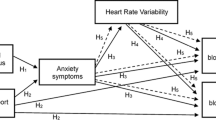Abstract
This study examined the effects of daily activities and social behavior on the blood-pressure elevation in 21 normotensives, 20 borderline hypertensives, and 20 sustained essential hypertensives. Blood pressures were recorded over a 24-hr period using an ambulatory monitor while subjects recorded their daily activities and social involvement at each cuff inflation. Results indicated that only a moderate proportion of the blood pressure readings of the two clinical groups exceeded 140/90 mm Hg. Results also suggested that the blood pressures of normotensives were more responsive to changes in physical activity, while the blood pressures of sustained hypertensives were more responsive to social involvement. When group differences emerged on mean blood-pressure elevation, analyses indicated that the two hypertensive groups frequently differed from the normotensive group but rarely from each other. The results suggest that differences in blood-pressure elevation cannot be fully understood without considering behavior and support its continued inclusion in the study of blood pressure.
Similar content being viewed by others
References
Bevan, A. T., Honour, A. J., and Scott, F. H. (1969). Direct arterial pressure recording in unrestricted man.Clin. Sci. 36: 329–344.
Bolen, K. G., Ramsey, L., and Gifford, R. V. (1984). Interfacing the Del Mar Avionics Model 1978 P3 System with the Apple 2E computer. In Weber, M. A., and Drayer, J. (eds.),Ambulatory Blood Pressure Monitoring, Springer-Verlag, New York pp. 35–41.
Crowther, J. H., Stephens, M. A. P., Koss, P. G., and Bolen, K. (1987). Behavioral predictors of blood pressure variation in hypertensives and normotensives.Health Psychol. 6: 569–579.
Dollery, C. T. (1973). Normal and raised arterial pressure: What is hypertension? In Onesti, G., Kim, K. E., and Moyer, J. H. (eds.),Hypertension: Mechanisms and Management, Grune & Stratton, New York.
Harshfield, G. A., Pickering, T. G., Kleinert, H. D., Blank, S., and Laragh, J. H. (1982). Situational variations of blood pressure in ambulatory hypertensive patients.Psychosom. Med. 44: 237–245.
Horan, M. J., Kennedy, H. L., and Padgett, N. E. (1981). Do borderline hypertensive patients have labile blood pressure?Ann. Intern. Med. 94: 466–468.
Laughlin, K. D. (1981). Enhancing the effectiveness of behavioral treatments of essential hypertension.Physiol. Behav. 26: 907–913.
Lynch, J. J., Long, J. M., Thomas, S. A., Malinow, K. L., and Katcher, A. H. (1983). The effects of talking on the blood pressure of hypertensive and normotensive individuals.Psychosom. Med. 43: 25–33.
Pickering, T. G., Harshfield, G. A., Kleinert, H. D., Blank, S., and Laragh, J. H. (1982). Blood pressure during normal daily activities, sleep, and exercise: Comparison of values in normal and hypertensive subjects.JAMA 247(7): 992–996.
Schneider, R. A., and Costiloe, J. P. (1975). Twenty-four hour automatic monitoring of blood pressure and heart rate at work and at home.Am. Heart J. 90: 695–702.
Seer, P. (1979). Psychological control of essential hypertension: Review of the literature and methodological critique.Psychol. Bull. 86: 1015–1043.
Shapiro, D., and Surwit, R. S. (1976). Learned control of physiological function and disease. In Leitenberg, H. (ed.),Handbook of Behavior Modification and Behavior Therapy, Prentice-Hall, Englewood Cliffs, NJ.
Williams, R. B., Kimball, C. P., and Williard, H. N. (1972). The influence of interpersonal interaction.Psychosom. Med. 34: 194–198.
Author information
Authors and Affiliations
Additional information
This research was supported in part by National Institutes of Health Grant HL 29795 to Janis H. Crowther and Mary Ann P. Stephens.
Rights and permissions
About this article
Cite this article
Stephens, M.A.P., Crowther, J.H., Koss, P.G. et al. Effects of daily activities and social behavior on blood-pressure elevation. J Behav Med 11, 553–563 (1988). https://doi.org/10.1007/BF00844905
Accepted:
Issue Date:
DOI: https://doi.org/10.1007/BF00844905




